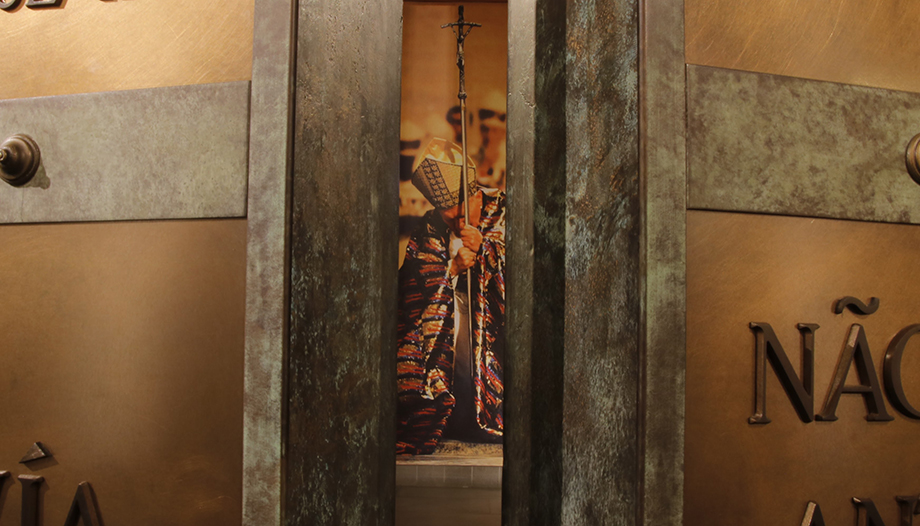On May 18, 1920, at five o'clock in the afternoon, Karol, the third child of the Wojtyla couple, was born. Eighty years later, on June 16, 1999, that child was John Paul II and he recounted his memories during a pastoral visit to his hometown: "Once again, during my ministry to the universal Church in the Holy See, I come to my hometown of Wadowice. I look with great emotion at this city of my childhood, which witnessed my first steps, my first words. The city of my family home, my baptismal church...".
In those days, he had an endearing encounter with thousands of people who filled the central square of Wadowice and the millions of Poles who followed the broadcast on television.
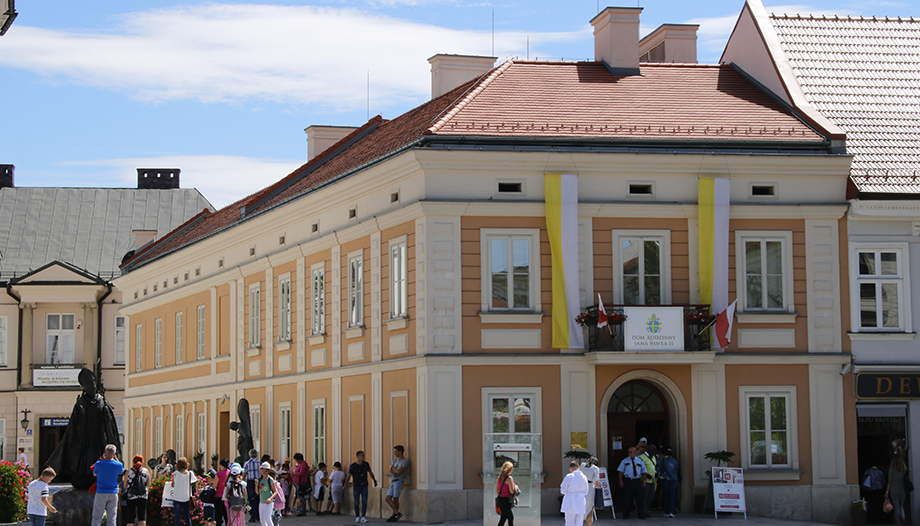
After that trip, one of the descendants of the owners of the building where little Karol had been born began negotiations with the Polish government to recover the property, which had been lost during the communist period. After a few years, once the complicated legal aspects had been solved, he was able to put it up for sale. That offer coincided in time with the death of John Paul II.
A prosperous businessman, moved by the exemplary life of the Polish Pope, decided to acquire the building and pay for the renovation project to open a new church there. John Paul II Family House Museum.
The entire building, which included the home rented by the Wojtylas, was adapted to house a modern narrative museum that allows visitors not only to learn about the life, work and teachings of St. John Paul II but also to take them on a journey back in time through Poland's most recent history.
The result is about 1200 m2 of exhibition space on four floors divided into sixteen zones. The heart of the museum is the Wojtyła's apartment, where Karol was born and lived for eighteen years. We describe in a synthetic way some of these areas.
Small homeland: Wadowice.
The part dedicated to the years of Karol's youth shows the roots of his personality and spirituality. Visitors can perceive the atmosphere of Wadowice in the 20s and 30s of the 20th century - as the future pope remembered it - full of cultural and spiritual richness.
Photographs of his family, friends and acquaintances, as well as of the prominent people of Wadowice, can be found there. In separate showcases you can see documents of great historical value, such as Karol Wojtyła's bachelor's degree and the manuscript of his curriculum vitae.
Wadowice at the beginning of the 20th century was a world where cultures and religions crossed, hence, in this area, the exhibition dedicated to the Jews of Wadowice, who constituted twenty percent of the city's inhabitants, was placed.
In the room designed as the pre-war store of Chiel Bałamuth, the owner of the building who rented the apartment to the Wojtyła's, numerous photographs are collected. Among them we find that of Jerzy Kluger, Karol's friend from elementary school days until the end of his life.
In this first area of the museum you can see objects related to two important places for the spirituality of the future Pope. The first of these is the scapular that Karol received in the Carmelite convent of Wadowice, the Carmelite convent "na Górce" (on the Mount), which is today one of the most valuable objects in the Museum. It was also there that Karol Wojtyła's fascination with Carmelite spirituality began, which found expression in his licentiate and doctoral work.
The Wojtyła family home
From 1919 to 1938 the Wojtyła's lived on the second floor of the house located at 9 Kościelna Street - Church Street (formerly Rynek 2 - the Main Square, gate 4). The house then housed Chiel Bałamuth's store as well as other stores and handicraft workshops, which constituted a kind of shopping center.
The Wojtyła's house consisted of three interconnected rooms: the kitchen, the bedroom and the living room. The house was accessed from the outer courtyard by a spiral staircase leading up to the landing where the door led directly into the kitchen.
The interior of the Wojtyła's home was reminiscent of houses of intellectual middle-class families. Today you can see its reconstruction based on the memories of Karol's neighbors and friends.
The dwelling decorated with period furniture and original objects belonging to the Wojtyła's, for example, napkins embroidered by Emilia Wojtyłowa, her handbag, a small gold pin, as well as family crockery and photographs from the family album.
In the bedroom the future Pope was born. After Emilie's death, when little Karol was left alone in the apartment with his father, this room became the main room of the house. In addition to the two beds, there was also the kneeler where - as John Paul II recalled - he often saw his father praying at night.
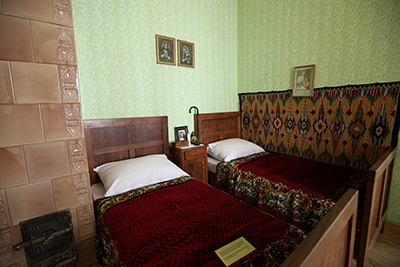
Through the kitchen window Karol could see on the wall of the parish church the sundial with the inscription "Time is running, eternity is waiting". Visitors to the museum can also see this clock today.
Krakow, I thank you
The Krakow stage occupied forty years of Karol's life, from his departure from Wadowice in 1938 to his election to the Petrine See in 1978. In this part of the exhibition you can see the objects that refer to the life of the future Pope from the time of the Second World War, related to his university studies, the work in the quarry of Zakrzówek or the formation to the priesthood.
After arriving in Krakow, Karol and his father lived at 10 Tyniecka Street, in a house that belonged to Robert Kaczorowski, his mother's younger brother.
In October 1938, the future pope began studying Polish philology at the Jagiellonian University, developing his passion for theater and poetry.
This part of the exhibition presents Karol Wojtyła as a worker in the Solvay chemical industry factory where he started working during the war, to avoid being deported to Germany at forced labor.
In the autumn of 1942 Karol Wojtyła decided to enter the Diocesan Seminary of Krakow, which was then operating clandestinely. On November 1, 1946, he was ordained a priest, from the hands of Archbishop Adam Sapieha, and the following day he celebrated his first Mass in the crypt of St. Leonard in the Krakow Cathedral.
A replica of that crypt can be visited in the museum. In the stained glass windows on the side you can see the prayer cards commemorating the first Mass of the priest Karol Wojtyła - one with the handwritten inscription and another card on the occasion of the 25th anniversary of his ordination to the priesthood.
The central object of this part - which heralds the next - is the last of several cassocks and John Paul II's first papal cassock with which he greeted those gathered in St. Peter's Square on October 16, 1978.
Sea inside!
In this room a large replica of a boat from the time of Christ, found on the shore of the Sea of Galilee near Capernaum, attracts the eye. The boat is the symbol of the Church - on October 16, 1979 the Cardinal of Krakow became its helmsman. In this area of the museum resound the words of Cardinal Pericle Felici, who in Latin announces to the assembled crowd: Habemus papam... The speech is complemented by a film documenting the moment of Karol Wojtyła's election to the Petrine See.
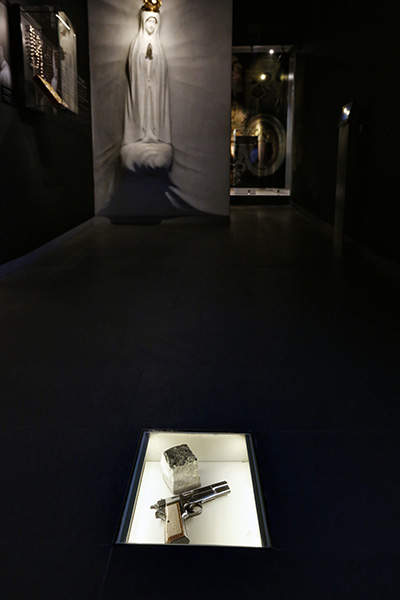
Further on, visitors pass through a dark room that introduces them to the events of May 13, 1981. On that day, in St. Peter's Square, John Paul II was the victim of an assassination attempt. The original gun with which Ali Agca shot him can be seen behind glass on the floor.
A multimedia screen that draws on photographs and documentary films as well as radio recordings reflects the terror of those moments. The silent witnesses are other objects - the suit of Francesco Pasanisi, one of John Paul II's bodyguards, with visible blood stains and also the painting of Our Lady of Częstochowa that was to be given to the Pope by one of the groups on the same day and in front of which - right after the attack - they all prayed in the Square.
It should be emphasized that this part of the exhibition is dedicated above all to the message of forgiveness and the power of prayer. Hence the large photographs of John Paul II's meeting with Ali Agca (December 27, 1983), whom the Pope forgave once he had recovered from the attack. The presence of the statue of Our Lady of Fatima recalls John Paul II's conviction that it was Our Lady who saved him: One hand fired, another hand deflected the bullet. In this area of the exhibition there is also the rosary offered to the Holy Father by Sister Lucia.
The Church built on the rock of love
John Paul II, being the head of the universal Church, also exercised the authority of the magisterium which is reflected in the fourteen columns that support the dome of the area of his magisterium where the covers of his fourteen encyclicals were placed.
In the center of the room is the replica of the Holy Door, opened (and closed) by John Paul II twice. Once in March 1983 (and in April 1984) and in December 1999 (and in January 2001).
On the front there are bas-reliefs of biblical scenes and the coats of arms of the 28 popes who opened the Holy Door.
The following inscription was placed on the back Do not be afraid! Open wide the doors to Christ. in ten languages. In the showcases you can also see the souvenirs related to the Great Jubilee of the Year 2000. There we find the pectoral cross and the mitre of John Paul II, made for the occasion, and the plate with the coats of arms of all the popes who inaugurated the Holy Years.
Leaving the room the visitor passes through another door. Its shape is reminiscent of the confessional grid - the symbol of the sacrament of confession, which liberates and strengthens.
In the apostolic journeys made during his pontificate, John Paul II traveled more than 1.5 million kilometers, visiting 129 countries. In this part of the museum visitors can "travel" to the places where the Pope visited.
Here are kept souvenirs related to these trips, often gifts received by John Paul II. A tapestry with the prayer "Our Father" in the language of the inuit(indigenous to the Arctic regions), the ebony bust of Christ from the Congo or the commemorative prints - the Marvel comic book with John Paul II on the cover (1982) and the album with the Pope's favorite songs (Mexico, 1979) are some of them.
The side wall is covered with a 15-meter-long multimedia screen that allows one to view photographs and read excerpts of the Holy Father's speeches from his 104 apostolic journeys.
The "youth" area consists of walls made up of hundreds of colorful plaques that together form a large image of John Paul II surrounded by young people. In addition, visitors can see themselves in a mirror on the opposite side and, symbolically, feel part of these pictures. On the small screens, parts of the documentary films of the World Youth Days of which John Paul II was the initiator can be seen.
How not to smile here when listening to the joyful dialogue with the young people when the Holy Father joked from the papal window in Krakow. The following showcases present the wooden boards with the logos of the World Youth Days (1986-2000) presented on the occasion of the Great Jubilee of the Year 2000.
This transience makes sense
In the basement of the museum visitors are encouraged to reflect on the passing of life. There, in a special way, the Pope's words "This fleetingness has meaning..." (Roman Triptych, Meditations...) resonate.
In these times, when people try to maintain youth at any price and deny old age and suffering in their conscience, the Pope reminds us that the passage of time has a profound meaning and is a path to fulfillment. Here visitors can accompany John Paul II in his passage to the afterlife.
One could not miss the replica of the sundial, the one Karol Wojtyła saw from the kitchen window, and the original clock in the papal apartments stopped on the day of the Pope's death at 21:37 hours.
You can also see the Bible from which Sister Tobiana Sobótka read to the dying Holy Father. In it, when the Pope died, the sister marked the sign of the cross in the place where he read and wrote the word "Amen".
A story that continues its course
Before leaving the museum, visitors are confronted with a singular question: "Why is John Paul II a saint? On a large multimedia screen are dozens of photographs of different people. There are known and unknown, clergy and laity, young and old, among whom there are those who had the chance to meet the Pope in person and those who never experienced him. By clicking on the photos, the visitor learns the answer each of them gave to the above-mentioned question.
For younger visitors at the exit there is a small wooden mechanical theater that briefly tells the story of the life of the Polish Pope - from his birth in Wadowice to the glory of heaven. Those who want to learn more about the life of the Holy Father, his teachings, his memoirs or simply get a souvenir of their visit to the Museum can visit the Museum's bookstore.
More than one million visitors
Four years ago in June 2018 the Museum of the Family House of the Holy Father John Paul II in Wadowice welcomed the "one millionth visitor". The lucky tourist turned out to be Monika, who came together with her husband to Wadowice from Kórnik little town near Poznan. Monika undertook to be an ambassador of the Museum of the Family House of the Holy Father John Paul II in Wadowice. There are many ambassadors like Monika all over the world.
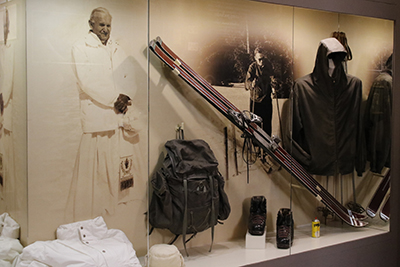
More than 80% of the visitors to the birthplace of John Paul II are Polish. Among the foreigners, there are many from Italy, France, the United States, Spain, Slovakia, Germany, Brazil, Austria and Great Britain. The Museum has welcomed pilgrims from more than 100 countries, including Barbados, Burkina Faso, Gabon, Cuba, Mauritius, Ivory Coast, New Zealand, China, Saudi Arabia, Zambia, Kenya and South Africa.
The Museum also organizes scientific and educational activities. Conferences and concerts are held every year on the occasion of papal anniversaries, and children and young people can participate in museum workshops. The birthplace of St. John Paul II has become a modern center of formation and catechesis. The affection for John Paul II has succeeded in uniting very diverse institutions: ecclesiastical, state, local and national. People of different religions and cultures feel moved and united wholeheartedly to this initiative.


